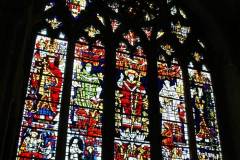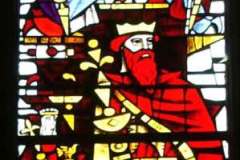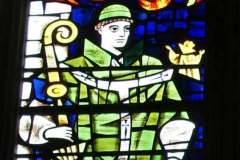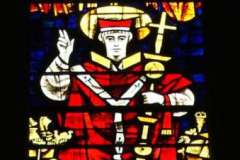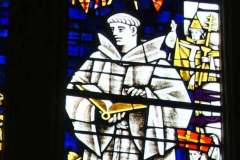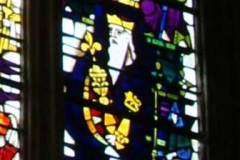This window in the Anselm chapel is the only example of a 14th century Decorated Gothic window in the cathedral and is in the Kent style with split cusps and pendants in the tracery. Harry Stammers (d 1969), a well-known stained glass designer from York, replaced the glass lost in WWII with this new brightly coloured glass in 1959 (Image 1). St Anselm was the second Norman archbishop between 1093 and 1109, a great theologian and initiated the building of the major extension of the earlier Norman church of Lanfranc. The main five lights show the five people important in his life and beneath each a story connected with each.
What to see (in the main lights, from the left):
- William II (Rufus) with below the scene of the king ill in bed (hence the grapes) thinking he was about to die thrusting the archbishop’s crozier into Anselm’s hand, belatedly appointing him (Image 2)
- Lanfranc was Anselm’s predecessor both at Canterbury but also at the French abbey of Bec. The scene below shows Lanfranc welcoming a youthful Anselm to the abbey many years before he became archbishop (Image 3)
- Anselm with a scene below of his most famous book ‘Cur Deo Homo’, ‘Why did God become man?’ This contains principles that are still relevant today, 900 years later (Image 4)
- Baldwin was a monk who looked after Anselm’s secular duties as Anselm had no interest in such matters. Beneath Anselm is shown in dispute with Henry I (Image 5)
- On the extreme left is Henry I with whom Anselm had a troubled relationship. Beneath, Anselm finally comes to terms with the King (Image 6)
- At the bottom of the right hand light, that of Henry I, there is Stammers’ ‘S’ and also his mark, a wheel that is part spoked wheel and part ship’s wheel as his father was a wheelwright and his father-in-law was a mariner.
AT

